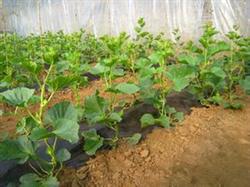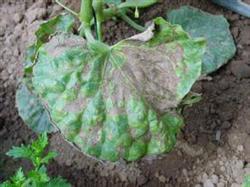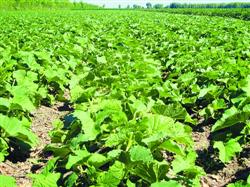Cultivation techniques of muskmelon in spring shed

Muskmelon production has developed rapidly, whether in greenhouse or spring shed production, the economic benefit is more significant, the income per mu is about 10,000 yuan. According to the characteristics of spring shed production, such as low investment, easy management, high output, good quality, short production cycle and fast occupation of the market, the management technology is now arranged for reference in order to promote the development of production. First, selecting land, fertilizing and ridging muskmelon are crops that like warm and cold, light and shade, early and waterlogging, so we should choose the quality of post or sandy soil, and sunny slope stubble land is better. It is better if there are water sources for irrigation and convenient transportation. Yellow clay and clayey soil are not suitable. The width of the shed is 6 mi 8 m (10 m with plastic film 8 m). The length depends on the land. The shed runs north-south, mostly bamboo and wood structure, or steel skeleton greenhouse. Before freezing, the melon land should be fertilized, rotary ploughed and ridged. Generally, high-quality farm manure 3000 kg, diammonium 10 kg, and potassium sulfate 15 kg should be applied per mu. After rotary tillage, the ridge can be ridged, with a width of 0.9 meters (including trail ditches). Second, the variety selection generally uses Qi Tian No. 1, Yumei and other sugars containing 14% of 15% sugar, and the growth period is 120 days. Third, raising seedlings, the time is chosen to be in the first and middle of February. There are two methods to treat the seeds. One is to soak the seeds in warm water. Soak the seeds in 55 ℃ warm water for 15 minutes. The seeds should be stirred while pouring into the water. The second is to soak in topiramate or carbendazim 500 Mel 700 times solution for about 4 hours, put it in the place of 25-30cC, and 1Mel sprouts in 2 days. Sow seeds after budding. With a nutrition bowl with a diameter of 8 cm and a height of 10 cm, the nutritious soil uses 50% mature high-quality fertilizer, 50% onion and garlic or corn soil, and the nutritious soil must be soaked and sterilized with 500 times 30% peracetic acid. Sow seeds seven days later and cover the soil 0.5 cm. It is best to use grafting to raise seedlings, the rootstock with holy rootstock No. 4, the method of top cross grafting, the survival rate is 98%. The main advantages are disease resistance, continuous cropping, no stubble, high yield, resistance to low temperature and high humidity, and saving fertilizer. The seedling age is about one month, but it should be noted that the seed germination time of rootstock is 4 days earlier than that of scion seed. Fourth, the planting time is in the middle and late March, and the melon seedlings are planted with 3 leaves and 1 heart. Buckle the greenhouse 30 days before planting to raise the ground temperature. The seedling bowl should be watered thoroughly in the afternoon or evening before planting, so as to bring the tuo to the ground. It is better for the pit surface to be slightly concave after soil cultivation. The suitable planting density is 90X50 cm double plant, or 90X33 cm single plant. As the melon root regeneration ability is strong, so try not to hurt the root during cultivation. 5. Pruning, heart-picking 1. Sun vine four-vine pruning method: pick the heart when the main vine is four-leaf, pinch off the one-leaf and two-leaf vine at the same time, leave the vine between three and four leaves, pick the heart when the vine grows to four leaves, each grandvine leaves 2 melons, each plant can keep 6-8 melons. two. Four-leaf pruning method: when the main vine grows to six leaves, pick the heart, pinch off the vine between the first and second leaves, and leave the vine between the six leaves. Each vine leaves 1 Mel and 2 melons. Sixth, topdressing. The principle is light fertilizer in seedling stage and heavy fertilizer in melon stage. When the melon grows to the size of the egg, it is necessary to chase melon fertilizer, using diammonium 7.5 ml 10 kg per mu, potash fertilizer 12.5 ml 15 kg, pay attention to potash fertilizer must use potassium sulfate, do not use potassium chloride, in order to prevent melon bitterness. 7. Irrigation during the melon expansion period, proper irrigation can increase the yield and improve the quality. when the number of melons reaches its peak, it is found that melon leaves can be irrigated during the daytime. 500 times peracetic acid (one or two pairs of two pots of water) is generally used. Eighth, pay attention to the prevention and control of diseases and insect pests (Sun Hongxu, Development and Service Center of famous, Special and excellent Agricultural products of Liaoning Province): sweet fertilization of watermelons is the key to Tianjin Agricultural Science and Technology Information Network. 1. The application of phosphorus, potassium and phosphorus can promote the formation, transportation and storage of carbohydrates. Therefore, the application of phosphorus and potassium fertilizer can increase the sugar content of watermelon, while the application of nitrogen fertilizer alone will reduce the sugar content. The experiment proved that the application of farm manure 3000Mu / mu of watermelon, followed by topdressing of phosphorus and potash fertilizer, had an obvious sweetening effect. Generally, after sitting watermelon, applying 10 kg potassium sulfate per mu can improve the sweetness of watermelon by 1 ml 2 degrees; spraying 0.2% potassium dihydrogen phosphate aqueous solution at the initial stage, or applying 5 kg phosphate fertilizer per mu at the early stage of vine extension. Spray sweetening solution in the middle and later stages of watermelon growth, spray sweetener to watermelon leaves. The formula of sweetening solution is: 30 grams of borax, 1000 grams of sucrose, 5 grams of calcium hydride and 50 kilograms of water. The sweetness of watermelon was increased by 1-2 degrees by spraying 25 Mu of 30 kg per mu. 3. Stevia bean fertilizer 0.5 kg stevia, 25 kg water, then 10 kg soybean. Soak in a human pot and boil the soybeans until they are dry. When sitting on a watermelon, apply it near the root and cover the soil with 3mi 5cm. 4. Apply saccharin soybean cake fertilizer to dissolve 300-500 grams of saccharin in 15murine 25 kg of water, add 5 kg of bean cake to boil, boil over low heat until dry, then sprinkle the bean cake and rice bran around the root of watermelon, cover with 3ml / 5cm soil. After this treatment, the sweetness of watermelon is equivalent to about 70% of the sweetness of white sugar.
- Prev

How to treat Leaf Blight of muskmelon in greenhouse
The disease is a bacterial disease, which mainly harms leaves, petioles and young melons, and can be damaged during the whole growth period. At the seedling stage, the susceptible cotyledons showed water-immersed yellow sunken spots, the back of the leaves was light green water-immersed spots at the initial stage of the disease, and gradually turned into light brown necrotic spots, and the spots were brittle and perforated after drying. The disease should be prevented.
- Next

Field management of melon in spring
Fertilizer base fertilizer is fully applied at one time, ditch 30 cm away from the plant, 50-100 kg potassium sulfate compound fertilizer per mu, or 2-3 square of mature livestock and poultry manure. Or 50-100 kg ternary bio-organic fertilizer, foliar sprayed with potassium dihydrogen phosphate + new high-fat membrane 600 / 800 times, and Huawang 3 balanced vegetative growth.
Related
- Moge, come on! The staff of the peasant association in the producing area of cantaloupe were frightened when the crowd gathered.
- Causes and Solutions of low Fruit setting rate of Apple
- Symptoms and control measures of passion fruit virus disease
- Fruit growing lesson: how do apple orchards keep high yields?
- Can you build orchards in the mountains? What are the pros and cons?
- How to manage the coloring period of Crisson grape?
- This paper introduces the processing technology of two kinds of fig products.
- How much is a month for retired teachers in rural areas by 2020?
- How can strawberry planting increase sugar content? We should pay attention to management in many aspects.
- What are the cultivation techniques on how to improve the yield of golden fruit?

